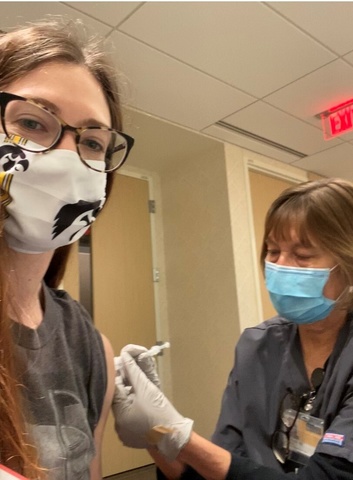Reminder: Campus health and safety guidelines
Gov. Kim Reynolds signed a new Public Health Disaster proclamation that became effective Sunday, Feb. 7, 2021. However, the policies and procedures adopted by the University of Iowa at the start of the fall semester remain in place.
To protect employee health and safety, students, faculty, and staff must:
- Wear applicable face coverings (cloth mask, disposable mask, or face shield with a mask) in all university buildings, including classrooms, unless alone in a private office/space or your residence hall room.
- Follow social distancing guidelines of maintaining at least 6 feet of separation from others on campus when feasible.
- Stay home if you develop any symptom(s) consistent with COVID-19 (cough, difficulty breathing, fever or chills, sore throat, muscle or body aches, loss of taste or smell, fatigue, headache, congestion or runny nose, nausea or vomiting, or diarrhea).
- Self-report positive test results, or that you've been identified as being in close contact with someone who tested positive for COVID-19.
- In-person events should not exceed 50 persons.
- All university meetings, to the greatest extent possible, will take place in an online format to maximize the amount of available classroom space.
The city of Iowa City and Johnson County also have face covering mandates, requiring face coverings to be worn in public places.
The university will continue to follow the latest guidance from the Centers for Disease Control and Prevention (CDC) in coordination with Johnson County Public Health, the Iowa Department of Public Health, and the Board of Regents, State of Iowa.
Vaccine update

The university is beginning to vaccinate and schedule vaccinations for select students and employees who are eligible under the Iowa Department of Public Health’s recommendations for Phase 1B, Tier 1. This includes College of Education students and faculty completing a field experience in a preK-12 classroom and first responders in the Department of Public Safety.
If you are eligible, you will be contacted to schedule an appointment.
The university also continues to successfully vaccinate faculty, staff, and students in Phase 1A who provide clinical patient care and are therefore vulnerable to high risk of exposure.
We continue to ask for your patience and support as we work through the process. The university is moving as quickly as the supply allows, but does not control when or how many doses it receives.
For additional information and updates, see coronavirus.uiowa.edu/vaccine-information.
Campus operations
The university continues to monitor self-reported COVID-19 testing data on campus, while also tracking state, region, and national COVID-19 infection rates.
University of Iowa self-reported COVID-19 testing
These data reflect new cases since Feb. 5, 2021.
The University of Iowa has published an updated snapshot of self-reported positive COVID-19 tests from faculty, staff, and students.
Number of self-reported cases of COVID-19
Students
- New cases: 7
- Total cases: 2,942
Employees
- New cases: 3
- Total cases: 431
These numbers reflect only self-reported positive or presumed positive COVID-19 tests from UI faculty, staff, and students on the academic campus since Aug. 18, 2020. These data will not match data reported by UI Hospitals & Clinics or by the Iowa Department of Public Health for several reasons, including different testing time intervals and geographic scope. Students who also are employees of the university are only reported in the student number to avoid double counting. The UI has more than 30,000 students and nearly 30,000 employees. Many employees continue to work remotely but have self-reported to authorize sick leave.
Number of residence hall students in quarantine: 0*
Number of residence hall students in self-isolation: 0**
*Quarantine: Quarantine is used to keep someone who might have been exposed to COVID-19 away from others.
**Self-isolation: Isolation is used to separate people infected with the virus (those who are symptomatic and those with no symptoms) from people who are not infected.